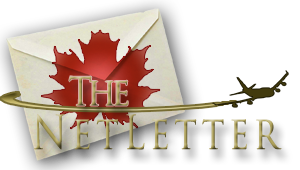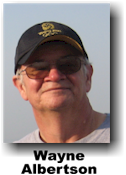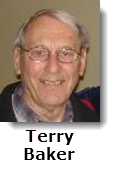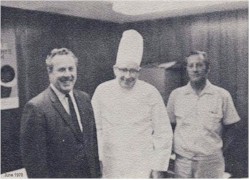|
|
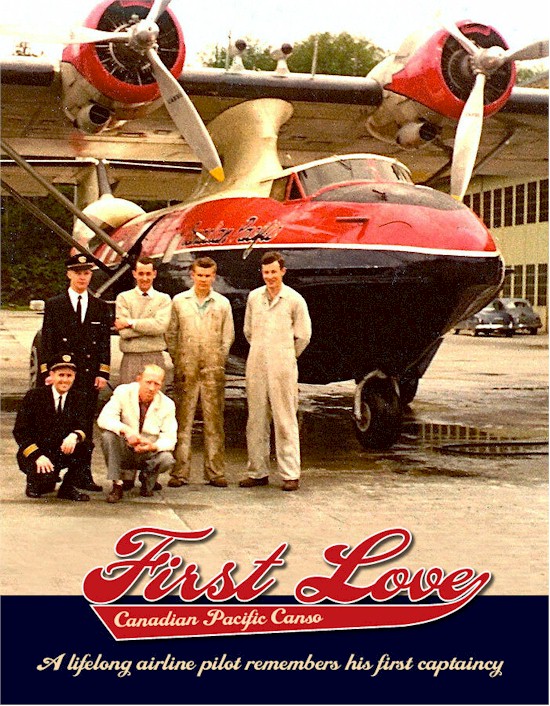 |
|
Air Canada Is Recognized as One of Canada's Best Diversity Employers for 2025
Air Canada was once again named one of Canada's Best Diversity Employers for 2025. It is the seventh time in 10 years Air Canada has received this recognition.
"We are very proud to be recognized again for our longstanding workplace diversity. As a global company connecting Canada to over 55 countries across the six inhabited continents, we have long subscribed to the importance of reflecting the best of Canada to our employees, customers and stakeholders," said Arielle Meloul-Wechsler, Executive Vice President, Chief Human Resources Officer and Public Affairs at Air Canada.
Source: media.aircanada.com
|
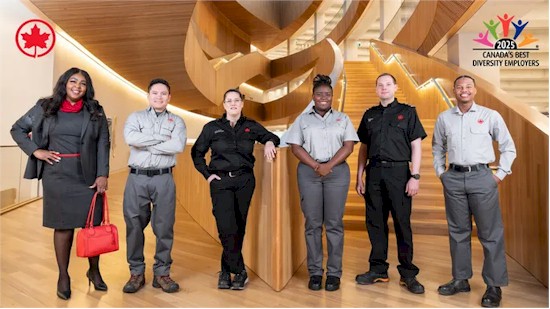 |
 for the latest posts at the Air Canada Media Centre. for the latest posts at the Air Canada Media Centre. |
 Click the logo to open the Air Canada YouTube channel. Click the logo to open the Air Canada YouTube channel. |
|
Terry Baker, co-founder of the NetLetter scours the internet for aviation related Trivia and Travel Tips for you, our readers, to peruse.
Spain enthusiastically built a $1.1 billion airport outside Madrid.
In the sun-scorched plains of central Spain sits a monument to ambition gone awry. Ciudad Real Central Airport with its gleaming terminal, pristine runway, and modern control tower, stands as a cautionary tale of economic hubris.
Built for over €1 billion (around $1.1 billion) during Spain’s construction boom of the early 2000s, this once-promising transportation hub would later earn the ignominious title of “ghost airport” after being auctioned off for just €10,000 (~$11,000) roughly the price of a steel Rolex Submariner watch.
Source: luxurylaunches.com
|
 |
 |
|
Extracted from issue dated May 1968
|
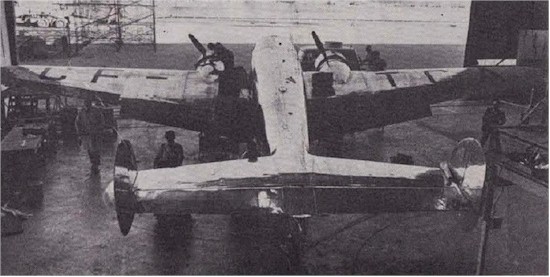 |
|
Colourful Career of CF-TCA
Peripatetic Orphan Flies into History
by B. R. Cormier The polished aluminum Lockheed L-10A now sitting at the Dorval Base began life with Trans-Canada Air Lines (TCA) in October, 1937 pretty much in its present, restored condition. But in between its arrival as TCA's first new aircraft and its reacquisition as a retiring pioneer lays countless thousands of miles and a career unparalleled in aviation history. Given the Canadian registration CF-TCA, it immediately entered service in 1937 with Trans-Canada Air Lines, the fledgling forerunner of the Company today. It flew the 122-mile Vancouver-Seattle route and others before being sold to the Department of National Defence on October 12, 1939 after logging 1,977 hours of TCA flying time.  |
|
Additional info regarding the remarkable career and preservation of CF-TCA
|
|
Doug Seagrim shares his personal memory of CF-TCA
My Father, Herb Seagrim, who joined TCA in 1937, on the first pilot course, was sent to the Lockheed factory in Burbank California to pick up CF-TCA (in 1937) and bring it to Winnipeg where it began its career. Because of that, when it was restored and delivered to the National Aviation Museum in Ottawa he was to do the flight, sort of a farewell gesture. At that time I was a Viscount pilot with the airline so it was decided that we would make it a father-son event and keep it in the family. As a result, I got to fly it to Ottawa and became the last person to fly it. Later, I also got to do the delivery of the Viscount CF-THI making me the last person to fly it as well and giving me a total of five aircraft in the Museum that I have flown. From Doug Seagrim - Retired Captain, TCA/Air Canada. |
|
Extracted from issue dated November 1968
Historic journey ends at Ottawa
|
 |
|
Final flight of the company's first aircraft, was made to the National Aviation Museum at Ottawa International Airport where it was handed over by Executive Vice President Herb Seagrim.
Seen above at the ceremony with Seagrim are the Honourable Gerard Pelletier, State Secretary, the Honourable James Richardson, representing Transport and Dr. David Baird of the Museum.
|
 for the full article. for the full article. |
|
Excerpt from Vancouver Sun August 31, 2024
This Day in History: First Trans-Canada Air Lines flight departs Vancouver
On September 1, 1937, the first Trans-Canada Air Lines flight took off from Vancouver. But it wasn’t flying across Canada — it was a short hop to Seattle. TCA’s first commercial passenger flight across Canada from Montreal to Vancouver wasn’t until April 1, 1939.
The Seattle flight was a big deal. The federal government launched the airline on April 10, 1937, and started operating in September after buying an established route, and two planes and their crews from Canadian Airways, a private company that was owned by James Richardson in Winnipeg. |
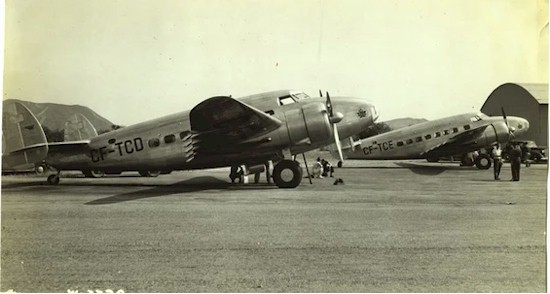 |
|
June, 1938. Two Lockheed 14 transports ready to take off for Vancouver, the western terminus of Trans-Canada Air Lines. The planes, part of a fleet of 10, were powered with two Pratt and Whitney geared Hornet engines of 850 HP each.
They were designed to carry 11 passengers, two pilots and a flight attendant, and have a top speed of 250 mph. The Maple Leaf emblem, insignia of the Dominion line, can be seen on the nose of the ships.
|
|
Nationair Canada operated charter as well as scheduled passenger services in the late 1980s and early 1990s from bases in Montreal and Toronto, with seasonal bases in Quebec City as well as flights out of Hamilton, Ontario to London, England. At one point, Nationair Canada was Canada's third largest airline, after Air Canada and Canadian Airlines International.
The company was founded by Robert Obadia, a former head of charter operations at Quebecair.
The airline was owned by its parent company Nolisair, which also owned Technair, an aircraft maintenance company. The airline's headquarters were located in the Nationair Canada Building at Montreal-Mirabel International Airport (YMX) in Mirabel, Quebec. Its fleet consisted of 30 aircraft over time.
Douglas DC-8-50CF - 1 Douglas DC-8-60 -11
Boeing 747-100 - 5
Boeing 747-200 - 4
Boeing 757-200 - 10 Source: en.wikipedia.org/wiki/Nolisair |
|
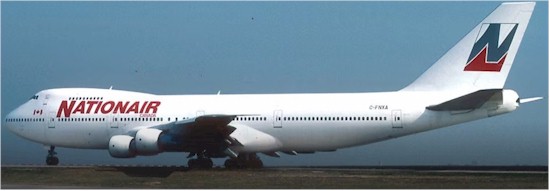 |
|
|
Boeing 747-200 - April 1990
Photo by Alain Durand |
|
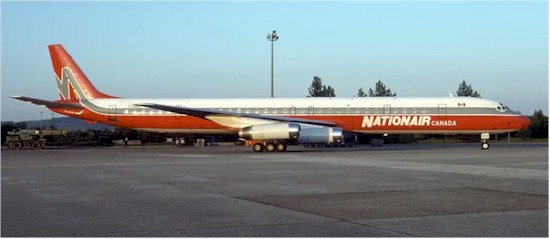 |
|
|
DC-8-63 - June 1987
Photo by Eduard Marmet
|
|
 |
|
|
Boeing 757-200 - March 1991
Photo by Michel Gilliand |
|
|
Pierre Gillard sends us this information -
Nolinor announced an agreement with Natilus, an aerospace producer based in San Diego, California, that is currently developing Blended-wing Body (BWB) aircraft. The agreement covers the reservation of positions for Kona-type aircraft, a turboprop designed to operate on gravel and unpaved runways as short as 800 meters.
With an announced payload of 3.8 tons, this aircraft is to be classified in the same category as Pascan's Saab 340B which can carry 3.4 tons.
However, thanks to its revolutionary design, its fuel consumption will be reduced by 30% compared to current aircraft. As for its range, it is estimated at 900 nautical miles (NM). We can't wait to see these Kona in Nolinor's colours!
|
|
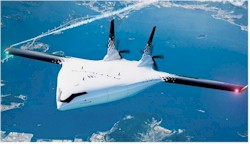 |
 |
